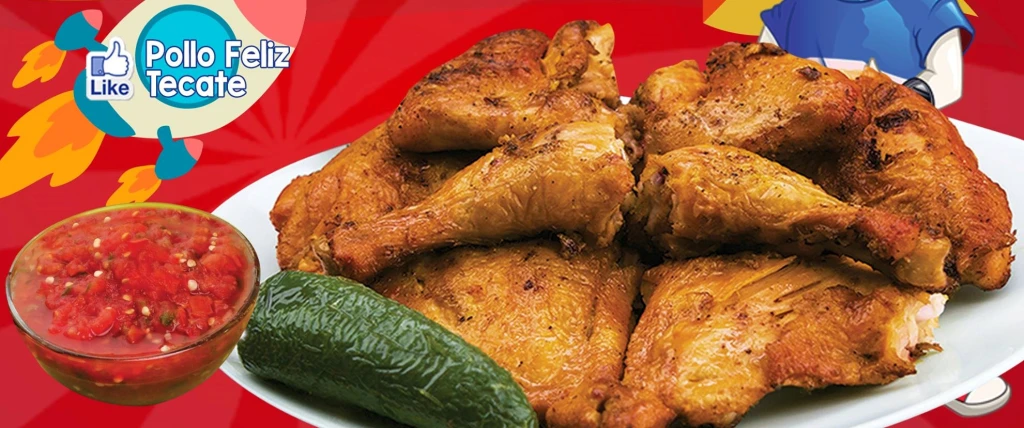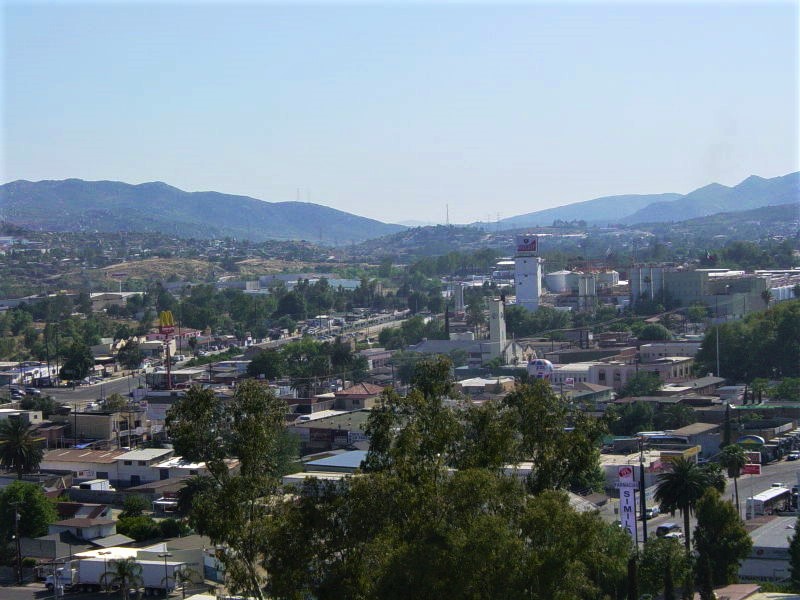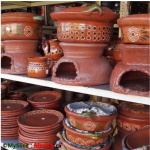
In my previous post, a meal of spatchcocked chicken and Tecate™ beer brought back memories of a short visit to the quaint city of Tecate, in the Mexican state of Baja California. My husband had an important project there with a deadline, back in January of 2006, so we requested a leave from grade school for our two daughters and the four of us lived in San Diego, California (in the USA) for part of December 2005 and into January of 2006. While my husband commuted to Tecate across the border for work (about a one-hour drive), I would homeschool the girls and then we had the afternoons to explore San Diego. We also got together with my mom, and my sister and her family, who were visiting the area; my mom did not have an American visa, so we all stayed in Tecate for a couple of days. One of our meals in Tecate was at Pollo Feliz™ (“Happy Chicken”) a chain specializing in grilled spatchcocked chicken:


Pollo Feliz™ is a popular restaurant not only in Tecate (Dr. Arturo Guerra F. # 20, El Pedregal, 21460 Tecate, B.C., Mexico), but across Baja California and many other places in Mexico and the USA. As other restaurant chains serving this type of chicken, such as Pollo Loco™ and Porti Pollos™, they originated in Sinaloa, Mexico, sometime in the mid 1970s, extending throughout Northern Mexico, and later expanding nationally and into some Southern states in the US. By free association of ideas, that is how I got that feeling of being back in Tecate. There is not a definite consensus about the etymology of the name, but the place definitely precedes the beer. The most likely interpretation is from the Kumeyaay language (spelled Kumiai in Spanish), of the indigenous groups who have inhabited the region on both sides of the American-Mexican border for millennia. Although there is also much debate about whether to classify their communities and languages as the Ipai, Kamia and Yipai, or just one under the Kumeyaay/Kumiai umbrella, their peoples consider themselves as one, and say they can understand each other, albeit after some adjusting. In this context, tecate means “where the sun shines” (from: “Baja Legends: The Historic Characters, Events, and Locations That Put Baja California on the Map” by Greg Niemann. Sunbelt Publications, 2002; p 67).
Tecate’s terrain comprises a valley and its surrounding hills, and several mountains, including the Kuuchamaa (Cuchamá, in Spanish), also known as the Tecate Peak in the United States:

During Spanish colonial times, missionaries and small communities arrived in the region, but it was not until 1829 when a great part of the valley, called Cañada de Tecate (Tecate Canyon) was granted to Juan Bandini, who established “Rancho Tecate”, the first written reference of the name; unfortunately the ranch was attacked by the locals and abandoned in 1838. A few decades later, other farmers arrived, recognizing the value of the fertile soil and perfect climatic conditions for grains, olives and grapes, becoming the Colonia Agrícola Tecate (Agricultural Borough of Tecate) by 1876. The town of Tecate was formally founded on October 12, 1892, and the municipality of Tecate was created in 1917. There is also a small river coming from the Tijuana river and running through the city, called Tecate Creek, and a hamlet across the border, the unincorporated community of Tecate, California, colloquially known as “Tecatito” – “Small Tecate”. The two Tecates constitute an important border crossing between the US and Mexico, much less hectic than the nearby crossing city of Tijuana, South of San Diego, California.
So, there is a mountain, as well as a river, an American hamlet and a Mexican city and municipality, all called Tecate, but, how about the beer? Tecate™ is also the name of a beer currently produced in several plants in Mexico and marketed internationally, but its story begins in the city of Tecate. A brick building built in 1929 had been used to produce vegetable oil, and in 1943, a man named Alberto Aldrete took over the business, also starting a small malt brewing operation on the side; he named his artisanal beer after the town, establishing its new enterprise as Cervecería Tecate™ in 1944. The brewery brought prosperity to the town, and by 1947, started exporting to Asian and American markets. In 1954, the company was bought by Cuauhtémoc Moctezuma™ Brewery, expanding its market and introducing the “easy open” cans to Mexico in 1964. The boost from the new management and convenient presentation gave the beer a great new market, and their logo became ubiquitous at beer depots, on table tops and the backs of folding chairs at road-side restaurants, and even supermarkets all around Mexico. Although at this point the plant in Tecate was also producing other beers as part of the larger brewery, the logo continued to be its iconic symbol:

For decades, this trend continued; I remember that red and gold can, with the black eagle logo, often set on our table for my dad during family daytrips when I was a kid:

The North American Free Trade Agreement (NAFTA) brought transnational industries to the city of Tecate starting in the 1990s; my husband’s employers acquired a manufacturing plant there in the early 2000s, where he was working in 2005-2006. Our walks around downtown included sights of old-fashioned shops, a small art gallery, and (shamefully) the only photo I could find of that trip, shows the corner of a nice cacti garden, with a classic yellow cab line-up in the background:

In 2012, because of its rich history. and its many natural and architectonic attractions, Tecate was granted the status of Pueblo Mágico – Magic Town. “Pueblo mágico” is a denomination granted by the Mexican Tourism Secretariat to recognize locations around the country with outstanding or unique features regarding their history, natural beauty, architecture, gastronomy or cultural heritage. The program started in 2001, and currently there are 121 magic towns, Tecate being the only location at the Mexican-American border, and the only Pueblo Mágico in the state of Baja California. Their old-fashioned park Miguel Hidalgo is one of the main features, which has preserved the traditional kiosk and continues to be a gathering spot and event site:

Tecate is a placid city, built against a beautiful backdrop of mountains:

As expected, there are many trails for rambling and hiking, or camping under the stars; the transitional climate between coastal Tijuana to the West and the semi-dessert region of Mexicali to the East has created varied habitats and vegetation in and around Tecate, ranging from low forest, to wine country, to cacti and succulent fields. There is the archeological zone of El Vallecito, with ancient antre and rock paintings in the nearby town of La Rumorosa, as well as many spas and retreat ranches.
In the 2010s, Heineken™ Breweries absorbed production of several Mexican beer brands, including Tecate™. The Tecate plant underwent general renovations, and in December of 2018, a new beer garden opened its doors. Although currently Corona™ (a Modelo/Anheuser-Busch beer) enjoys the title of best-seller Mexican beer, Tecate usually ranks higher in blind tasting tests, and has had a renaissance under Heineken™, with the opening of new markets around the World, and innovative TV commercials, such as this funny yet clever one, released during the time of the 2016 US presidential election:
Here in Canada, I was able to build my own three-can “beer wall” for under $10 CAD:









I really enjoy your history lessons and the family connections to places. I had never thought about the origins of the Tecate name.
LikeLiked by 1 person
Thank you, Eilene! To be honest, I didn’t, either, until my husband started travelling there, hehe.
LikeLiked by 1 person
Very interesting, thank you for the information!
LikeLiked by 1 person
What other beer is it equivalent to in taste? Just so I have an idea….
LikeLike
Tecate is a pale lager, so I would say a little like Beck’s, maybe a tad more bitter?
LikeLiked by 1 person
Very interesting background. And I’ll want to keep the town(s) [Tecate and Little Tecate] in mind in case I cross the U.S./Mexican border again someday.
LikeLike
Yes, definitely a quieter crossing compared to Tijuana.
LikeLike
Irene, I often wonder if you started out as an ethnographer or ethnohistorian. Great details presented in a very clear context.
LikeLike
My background is in Physics and then I specialized in Materials Science, so that training has definitely modeled the way I develop the topics for my posts. They might start with a recipe, a memory, or as in this case, by free association of ideas, but then I like to find out about their background to get the whole picture. Thank you for the ethnohistorian guess, Louis, I often think that if I were a youngster now, I would have liked to become an ethnobotanist.
LikeLike
Such an interesting personalized travelogue.
Wish I liked beer!
LikeLike
Thank you! I can’t tolerate too much alcohol, so I usually just get a sip from my husband’s drinks. We can still use beer for marinating or in batters, hehe.
LikeLike
I like that ad. I’m going to look out for the beer
LikeLiked by 1 person
Well, thanks for making me reconsider making a post about Tecate! You always take the high road. I might still pursue a Tecate post but yours is a treasure!
LikeLiked by 1 person
I haven’t been to the town in 15 years, and I really don’t know much about beer, so I will be looking forward to reading your post, whether about the beer or the town (or both)!
LikeLiked by 2 people